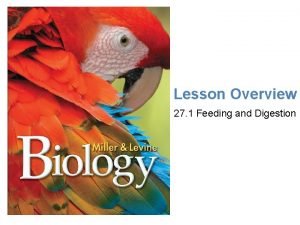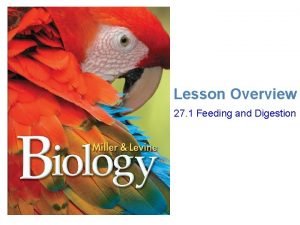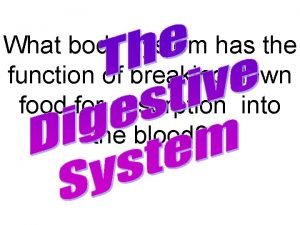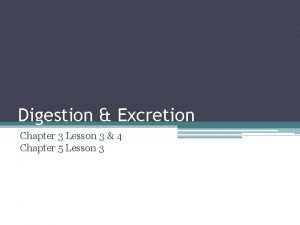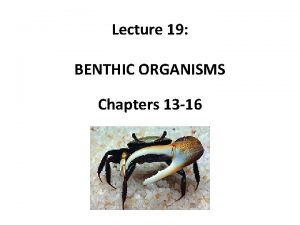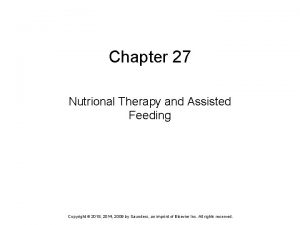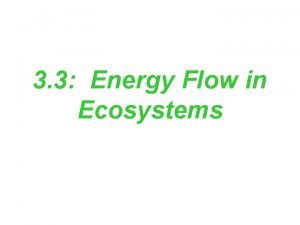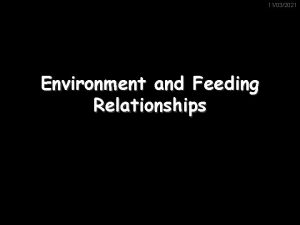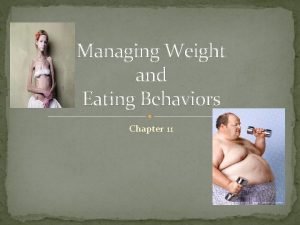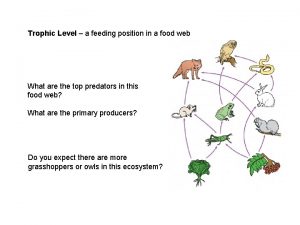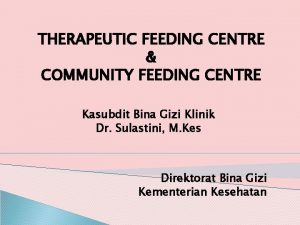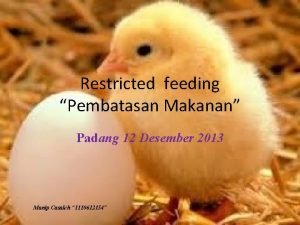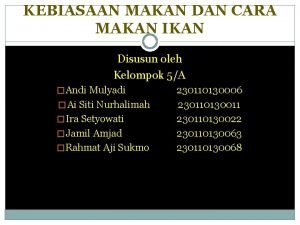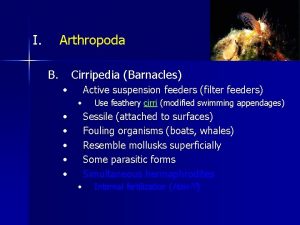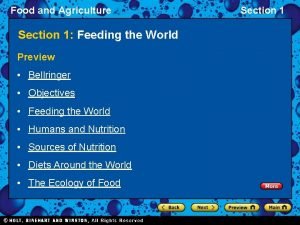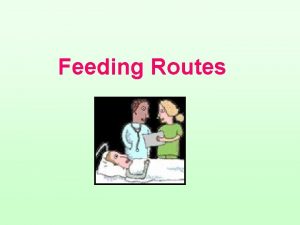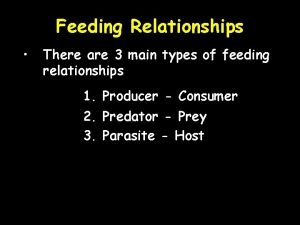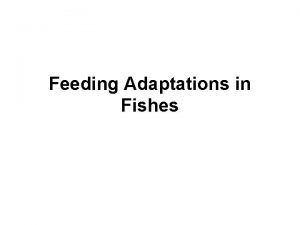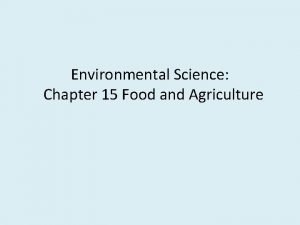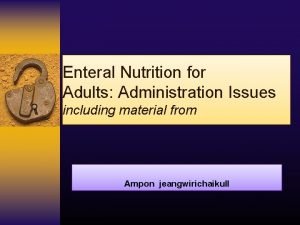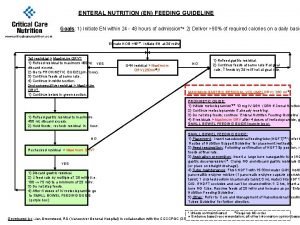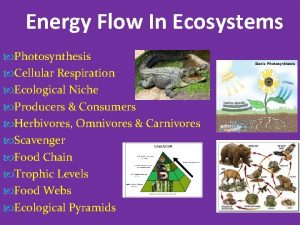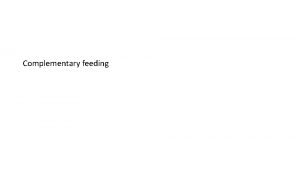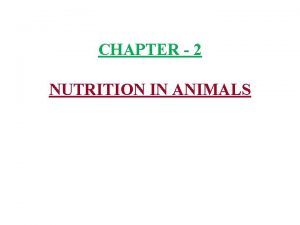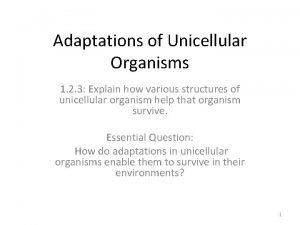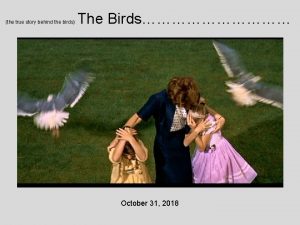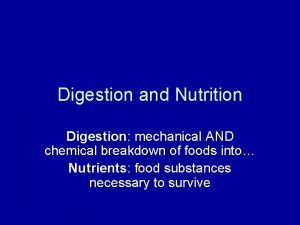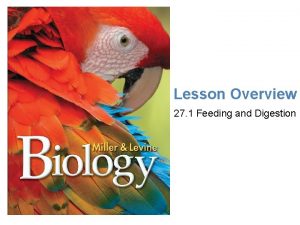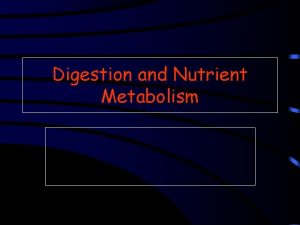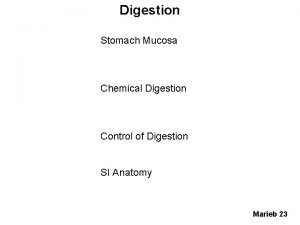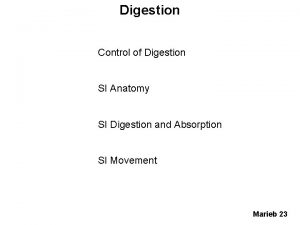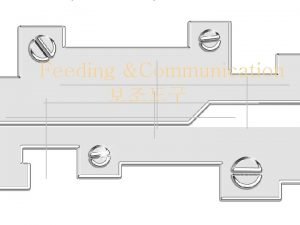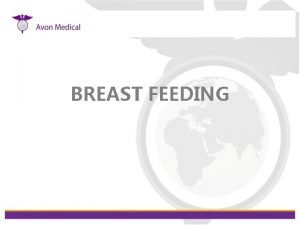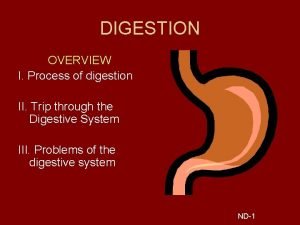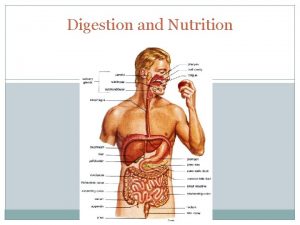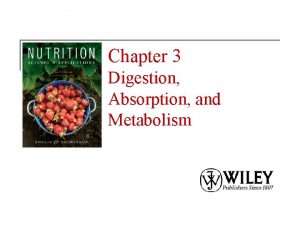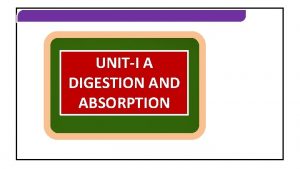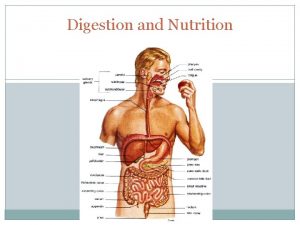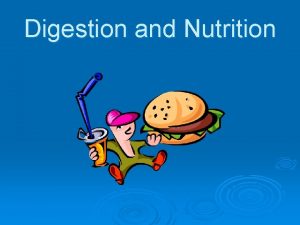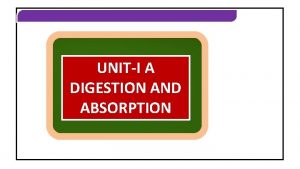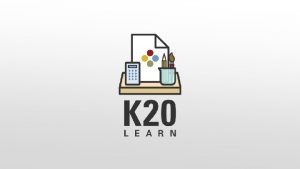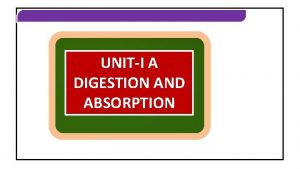Lesson Overview Feeding and Digestion Lesson Overview 27
































- Slides: 32

Lesson Overview Feeding and Digestion Lesson Overview 27. 1 Feeding and Digestion

Lesson Overview Feeding and Digestion THINK ABOUT IT From tiny insects that dine on our blood, to bison that feed on prairie grasses, to giant blue whales that feed on plankton, all animals are heterotrophs that obtain nutrients and energy from food. In fact, adaptations for different styles of feeding are a large part of what makes animals so interesting.

Lesson Overview Feeding and Digestion Obtaining Food How do animals obtain food?

Lesson Overview Feeding and Digestion Obtaining Food How do animals obtain food? Most filter feeders catch algae and small animals by using modified gills or other structures as nets that filter food items out of water.

Lesson Overview Feeding and Digestion Obtaining Food How do animals obtain food? Detritivores feed on detritus, often obtaining extra nutrients from the bacteria, algae, and other microorganisms that grow on and around it. Carnivores eat other animals.

Lesson Overview Feeding and Digestion Obtaining Food How do animals obtain food? Herbivores eat plants or parts of plants in terrestrial and aquatic habitats. Many animals rely upon symbiosis for their nutritional needs.

Lesson Overview Feeding and Digestion Obtaining Food As the old saying goes, you are what you eat. For animals, we can rephrase that as “how you look and act depends on what and how you eat. ” The converse is also true: What and how you eat depends on how you look and act.

Lesson Overview Feeding and Digestion Filter Feeders Most 1. filter feeders catch algae and small animals by using modified gills or other structures as nets that filter food items out of water. Many invertebrate filter feeders are small or colonial organisms, like worms and barnacles that spend their adult lives in a single spot. Many vertebrate filter feeders such as whale sharks and blue whales, on the other hand, are huge, and feed while swimming.

Lesson Overview Feeding and Digestion Detritivores 2. Detritivores feed on detritus, often obtaining extra nutrients from the bacteria, algae, and other microorganisms that grow on and around it. Detritus is made up of decaying bits of plant and animal material. From earthworms on land to a wide range of aquatic worms and crustaceans like the cleaner shrimp, detritivores are essential components of many ecosystems.

Lesson Overview Feeding and Digestion Carnivores 3. Carnivores eat other animals. Mammalian carnivores, such as wolves or orcas, use teeth, claws, and speed or stealthy hunting tactics to bring down prey. Some carnivorous invertebrates, such as cnidarians, paralyze prey with poison-tipped darts, while some spiders immobilize their victims with venomous fangs.

Lesson Overview Feeding and Digestion Herbivores eat plants or parts of plants in terrestrial and aquatic habitats. Some herbivores, such as locusts and cattle, eat leaves, which don’t have much nutritional content, are difficult to digest, and can contain poisons or hard particles that wear down teeth. Other herbivores, including birds and many mammals, specialize in eating seeds or fruits, which are often filled with energy-rich compounds.

Lesson Overview Feeding and Digestion Nutritional Symbionts 5. Many animals rely upon symbiosis for their nutritional needs. Symbiosis is the dependency of one species on another. Symbionts are the organisms involved in a symbiosis.

Lesson Overview Feeding and Digestion Parasitic Symbionts 6. Parasites live within or on a host organism, where they feed on tissues or on blood and other body fluids. Some parasites cause serious diseases in humans, livestock, and crop plants. Parasitic flatworms and roundworms afflict millions of people, particularly in the tropics.

Lesson Overview Feeding and Digestion Mutualistic Symbionts 7. In mutualistic relationships, both participants benefit: Reef-building corals depend on algae that live within their tissues for most of their energy. The algae, in turn, gain nutrition from the corals’ wastes and protection from algae eaters. Animals that eat wood or plant leaves rely on microbials in their guts to digest cellulose.

Lesson Overview Feeding and Digestion Processing Food How does digestion occur in animals?

Lesson Overview Feeding and Digestion Processing Food How does digestion occur in animals? Some invertebrates break down food primarily by intracellular digestion, but many animals use extracellular digestion to break down food.

Lesson Overview Feeding and Digestion Intracellular Digestion 8. The simplest animals, such as sponges, digest food inside specialized cells that pass nutrients to other cells by diffusion. This digestive process is known as intracellular digestion.

Lesson Overview Feeding and Digestion Extracellular Digestion Most more-9. complex animals rely on extracellular digestion. Extracellular digestion is the process in which food is broken down outside cells in a digestive system and is then absorbed.

Lesson Overview Feeding and Digestion Gastrovascular Cavities Some animals have an interior body space whose tissues carry out digestive and circulatory functions. Some invertebrates, such as 10. cnidarians, have a gastrovascular cavity, a single opening through which they both ingest food and expel wastes.

Lesson Overview Feeding and Digestion Gastrovascular Cavities Some cells lining the gastrovascular cavity secrete enzymes and absorb digested food. Other cells surround food particles and digest them in vacuoles. Nutrients are then transported to cells throughout the body.

Lesson Overview Feeding and Digestion Digestive Tracts 11. Many invertebrates and all vertebrates, digest food in a tube called a digestive tract, which has 2 openings. Food moves in one direction, entering the body through the mouth. Wastes leave through the anus.

Lesson Overview Feeding and Digestion Digestive Tracts One-way digestive tracts 12: often have specialized structures, such as a stomach and intestines, that perform different tasks as food passes through them. In some animals, the mouth secretes digestive enzymes that start involves chemical digestion of food. and Mechanical digestion in the mouth may occur as specialized mouthparts or a muscular organ called a gizzard breaks food into small pieces.

Lesson Overview Feeding and Digestion Digestive Tracts Chemical digestion begins or continues in a stomach that secretes digestive enzymes. 13. Chemical breakdown continues in the intestines, sometimes aided by secretions from other organs such as a liver or pancreas. Intestines also absorb the nutrients released by digestion.

Lesson Overview Feeding and Digestion Solid Waste Disposal No matter how efficiently an animal breaks down food and extracts nutrients, some indigestible material will always be left. These 14. solid wastes, or feces, are expelled through the single digestive opening, or anus.

Lesson Overview Feeding and Digestion Specializations for Different Diets How are mouthparts adapted for different diets?

Lesson Overview Feeding and Digestion Specializations for Different Diets How are mouthparts adapted for different diets? Carnivores typically have sharp mouthparts or other structures that can capture food, hold it, and “slice and dice” it into small pieces. Herbivores typically have mouthparts adapted to rasping or grinding.

Lesson Overview Feeding and Digestion Specialized Mouthparts 15. Carnivores and herbivores usually have very different mouthparts.

Lesson Overview Feeding and Digestion Eating Meat 16. Carnivorous mammals have sharp teeth that grab, tear, and slice food like knives and scissors would. The jaw bones and muscles of carnivores are adapted for up-anddown movements that chop meat into small pieces.

Lesson Overview Feeding and Digestion Eating Plant Leaves To digest leaf tissues, 17. herbivores usually need to tear plant cell walls and expose their contents. Many herbivorous invertebrates have mouthparts that grind and pulverize leaf tissues, adapted for side-to-side “grinding” movements

Lesson Overview Feeding and Digestion Eating Plant Leaves Herbivorous mammals, such as horses, have front teeth and muscular lips adapted to grabbing and pulling leaves, and flattened molars that grind leaves to a pulp. The jaw bones and muscles of mammalian herbivores are also adapted for side-to-side “grinding” movements.

Lesson Overview Feeding and Digestion Specialized Digestive Tracts 18. Carnivorous organisms typically have short digestive tracts that produce fast-acting, meat-digesting enzymes. These enzymes can digest most cell types found in animal tissues.

Lesson Overview Feeding and Digestion Specialized Digestive Tracts 19. No animal produces digestive enzymes that can break down the cellulose in plant tissue. However, some herbivores have very long intestines or specialized pouches in their digestive tracts that harbor microbial symbionts that digest cellulose. Cattle, for example, have a pouchlike extension of their stomach called a rumen (plural: rumina), in which symbiotic bacteria digest cellulose. Animals with rumina, or ruminants, regurgitate food that has been partially digested in the rumen, chew it again, and reswallow it. This process is called “chewing the cud. ”
 Lesson 11: feeding and digestion
Lesson 11: feeding and digestion Lesson 11: feeding and digestion
Lesson 11: feeding and digestion Specialized nutrition support
Specialized nutrition support Chemical and mechanical digestion venn diagram
Chemical and mechanical digestion venn diagram Digestion and excretion lesson 3
Digestion and excretion lesson 3 Suspension feeding
Suspension feeding Chapter 27 nutritional therapy and assisted feeding
Chapter 27 nutritional therapy and assisted feeding Chapter 18 eating and feeding disorders
Chapter 18 eating and feeding disorders Feeding relationship showing one path of energy flow
Feeding relationship showing one path of energy flow Environment and feeding relationship
Environment and feeding relationship Oral placement therapy for speech clarity and feeding
Oral placement therapy for speech clarity and feeding Chapter 11 managing weight and eating behaviors
Chapter 11 managing weight and eating behaviors Whats trophic level
Whats trophic level Therapeutic feeding center adalah
Therapeutic feeding center adalah Restricted feeding adalah
Restricted feeding adalah Tilapia feeding guide philippines
Tilapia feeding guide philippines Night of the scorpion poem text
Night of the scorpion poem text Mt washington feeding clinic
Mt washington feeding clinic Cara memakan ikan
Cara memakan ikan Sedentary suspension feeders
Sedentary suspension feeders Section 1 feeding the world
Section 1 feeding the world Routes of feeding
Routes of feeding 3 main types of feeding relationships
3 main types of feeding relationships Fish mouth adaptations
Fish mouth adaptations Active reading feeding the world
Active reading feeding the world Enteral nutrition
Enteral nutrition Enteral feeding guideline
Enteral feeding guideline Which feeding level represents the primary consumers
Which feeding level represents the primary consumers Principle of complementary feeding
Principle of complementary feeding Process of feeding in amoeba
Process of feeding in amoeba Unicellular organisms
Unicellular organisms Plateau characteristics
Plateau characteristics Suspension feeding
Suspension feeding
